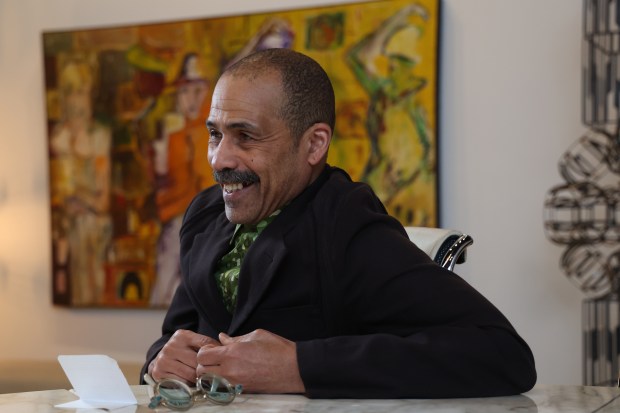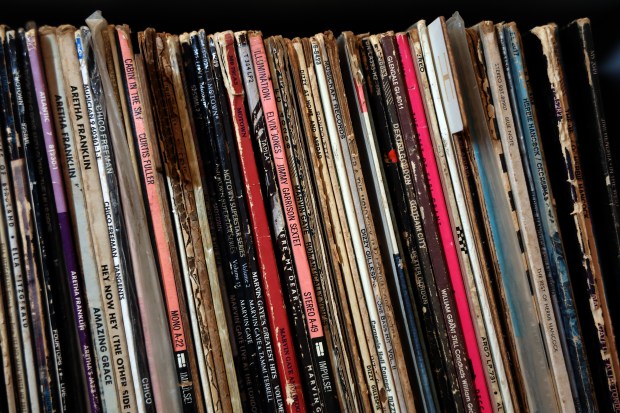Kahil El’Zabar was a teenager when he got the best advice of his life.
At the time, the percussionist was learning at the feet of multi-instrumentalist Muhal Richard Abrams, the founding president of the South Side’s Association for the Advancement of Creative Musicians (AACM). But dogged focus on technique, Abrams cautioned, only went so far.
“He told me the person who has concept will always go further than the person that can play,” El’Zabar recounts. “Because if you only know how to play, then you have to be placed in the concept of someone else.’”
El’Zabar’s Ethnic Heritage Ensemble is nothing if not a group with a concept. “Spiritual jazz” has become an ever-squishier genre tag, but for the Ethnic Heritage Ensemble, no other name fits. El’Zabar chants hypnotically over cycling grooves, usually tinged with the sound of the kalimba (a thumb piano similar to the mbira). It’s the music of higher communion. Listeners don’t have to be believers to feel that, viscerally.
But for years, the trio’s unconventional instrumentation — malleable through the decades, but always flanking El’Zabar’s percussion and vocals with two horns — even set it on the fringe of the famously catholic AACM.
“Our society has relegated rhythm and drummers to a primal, lesser role. I had to fight for respect as a leader, as a conceptualist, as a composer,” El’Zabar says.
This year, the Ethnic Heritage Ensemble turns 50. El’Zabar, who grew up in Chatham, certainly doesn’t look 70. Impeccably garbed, he stands ramrod straight and has only a whisper of gray in his thick mustache. The ensemble’s new album — “Open Me, A Higher Consciousness of Sound and Spirit” — came out earlier this month to commemorate the occasion. When he spoke to the Tribune in the chic, high-ceilinged Little Village apartment he shares with his wife, artist Lucy Slivinski, El’Zabar had just returned from a whirlwind anniversary tour with the ensemble: 27 cities in 33 days.
But one senses ambivalence from El’Zabar in notching the milestone. And not a small amount of annoyance. Even by the noncommercial standards of the AACM, El’Zabar seldom enjoys the same renown as his peers. Like other AACM musicians, El’Zabar dove into New York’s loft jazz scene and lived abroad in Europe. France’s cultural minister has named him a chevalier. He’s responsible for the Broadway “Lion King’s” Africanized arrangements of Elton John and Tim Rice’s originals; El’Zabar was hand-picked for the task by Julie Taymor. He was the Tribune’s 2004 Chicagoan of the Year in Jazz.
By the same token, it’s been 23 years since El’Zabar headlined his hometown’s own jazz festival.
“People ask me if I’m excited about all this new media,” El’Zabar says, his voice flat. “But why did it take 50 years for people to say what I’m doing is of a certain credibility?”
El’Zabar was a working musician by the time he was in high school, attending the now defunct Holy Name Cathedral High School on a basketball scholarship. He recorded with pop and R&B acts, then toured with saxophonist Gene Ammons’ band, at guitarist George Freeman’s recommendation and with his parents’ reluctant blessing.
“He’d hit a note and the whole room would just …” El’Zabar spreads his hands outwards from his cheeks to imitate a small supernova. “Most kids wanted to be athletes, or movie stars, or whatever those things were that are considered the adrenaline lift of being somebody. I couldn’t see anything greater than being a jazz musician.”
Between music and athletics, El’Zabar helped out at his family’s bridal and formal wear shop in Evergreen Park. El’Zabar helped keep the books. (He also picked up a passion for sewing, and he still makes many of his own clothes.) Working there taught him organizational skills and fiscal good sense in time for his preternaturally young appointment as chair of the AACM, from 1975 to 1980. El’Zabar was just 21 when he started.
“We developed a different level of grantsmanship. Yeah, we can do our festival at McCormick Place, at the Conrad Hilton Ballroom. It costs money, but you can get corporate sponsorships,” he says. “It’s a matter of being able to talk to people for the things that you believe are necessary to move your agenda forward.”
As for El’Zabar’s involvement with the AACM itself, his parents were supportive, if skeptical. They urged El’Zabar towards a liberal arts education to “acquire some skills” — which he did, at Lake Forest College — and would interrogate Abrams whenever the older musician picked El’Zabar up for gigs in his station wagon.
“They’d be like, ‘Well, Richard, you know, does he have a future in this?’” he remembers.
That support was briefly strained when El’Zabar, just 16, changed his name. Musicians in his nightly drum circle at Hyde Park’s Promontory Point had recently done the same; El’Zabar, inspired, lifted a new surname from mother’s Eritrean heritage. His father cried when El’Zabar told him, “because I was Clifton Blackburn Jr.”
“I just had to make this grow for an identity I was searching for,” El’Zabar says.
He found it, partly, in Africa, during a college study abroad program. At the time, Lake Forest only had an exchange program to Paris. Luckily for El’Zabar, the director of Black Studies at Northwestern University was an acquaintance, and personally invited El’Zabar to that school’s program at the University of Ghana, in Accra. The experience changed El’Zabar profoundly.
“I thought, no one calls anything the African American does an ‘ethnic heritage.’ If you’re from Nigeria, you have an ethnic heritage. If you’re from Germany, France, China, you have an ethnic heritage. How is it that the community that I evolved from is without that identity?” he asks.
He claimed it for himself with the Ethnic Heritage Ensemble. The musicians he’d met in Ghana saw “no limitations to instrumentation and ensemble,” and the West African indigenous music he studied there informed his eventual tilt away from drum kit into hand drums, kalimba, ankle bells and rattles.
The Ethnic Heritage Ensemble’s earliest incarnation looked very different from today’s tight trio. Its inaugural performance in 1974, at a church in Chatham, was nine performers strong. After that, the group briefly operated as a quintet.
From 1976 onwards, though, the Ethnic Heritage Ensemble settled into the two-horns-and-El’Zabar model that would sustain it for decades. Reviewing an Ethnic Heritage Ensemble set at the Chicago Jazz Festival in 1979, Tribune critic Harriet Choice wrote that it was “astonishing that only three musicians could creat(e) so many moods.”
Today, trumpeter Corey Wilkes and baritone saxophonist Alex Harding guide the sound into something more rooted and earthy than the lean, balletic lyricism of longtime members Edward Wilkerson (saxophone) and Joseph Bowie (trombone). Trombonist Craig Harris and saxophonists Ernest Dawkins, Hamiet Bluiett and “Light” Henry Huff also passed through its ranks.
“(At first) the band was scared of this unique instrumentation, and the limitations associated with it. But I have to say, I was never scared. My thing was, work with what you’ve got,” El’Zabar says.
They’ve done more than that. Save pandemic interruptions, the ensemble has toured every year since 1974 — a longevity and industriousness matched only by the Art Ensemble of Chicago, among AACM groups. Even in lean years, the ensemble could count on Black History Month gigs.
“You’ve got a group called the Ethnic Heritage Ensemble, and they have this new holiday. Somebody’s gonna hire you, because you’re appropriate to the theme of the month. So, at least for one month every year, we had at least 20 concerts,” El’Zabar says.

El’Zabar admits he hasn’t been the most fastidious documenter of the ensemble’s history — he was too busy living it. The photos and ephemera in his personal collection are few. Even gathering his own records requires some outsourcing. He recently learned “Live Without Fear,” cut in 1979 with an ensemble led by pianist Soji Ade, is now worth $4,500.
“I started calling my cousins, trying to remember who I gave one to when we first did it,” he says.
Rather than dwell in the past, El’Zabar is more concerned with safeguarding jazz’s future. He’s linked up with more than a dozen other artists to start Ooh Now (Oracles of Humanity, Network of Wisdom), a media, event and consulting company with a goal to safeguard revenue streams elided by streaming and view-based algorithms.
“The writer and actor strike happened, and Netflix, Google and all these companies coalesced and decided AI content was a viable economic alternative. Artists became very upset and disillusioned by it, but in reality, there was no alternative distribution mechanism,” El’Zabar says. “Imagine if all those millionaire writers and actors pulled together to create an alternative network. They would have had a much better position of negotiation.”
El’Zabar says Ooh Now is going to be his “last project.” It’s a worthy coda to a life spent defending musicians’ creative integrity — he was a founding member of the National Campaign for Freedom of Expression, founded out of the artistic censorship battles of the late 1980s — as well as his own.
“It’s just like the AACM. If we artists don’t do it ourselves, it’s not gonna get done,” he says.
“Open Me, A Higher Consciousness of Sound and Spirit” out now, with a listening party for the album 6-9 p.m. March 17 at Bronzeville Winery, 4420 S. Cottage Grove Ave., free; more at facebook.com/EthnicHeritageEnsemble and www.bronzevillewinery.com
Hannah Edgar is a freelance critic.
The Rubin Institute for Music Criticism helps fund our classical music coverage. The Chicago Tribune maintains editorial control over assignments and content.




